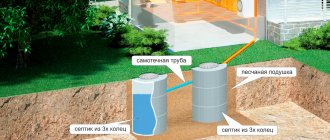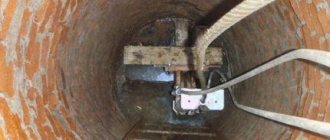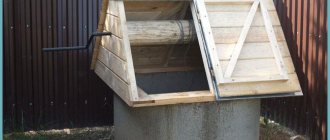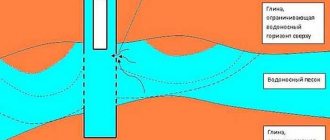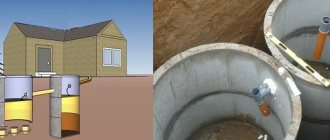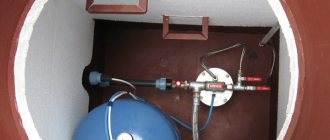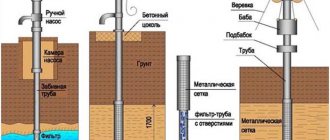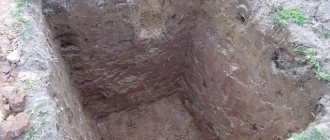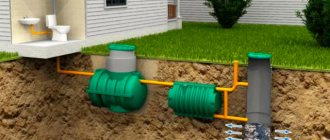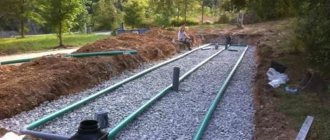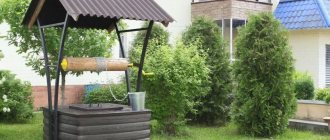Over time, sediment, debris, clay and silt accumulate in the well. To maintain the necessary freshness of drinking water, the owner will have to regularly clean the bottom and shaft. The frequency of the procedure depends on the composition of the water, the type of soil and other features of the area, but cleaning should be carried out at least once every five years. Cleaning a well is not difficult - we will look at the main methods in this article.
Timely cleaning is the key to obtaining high quality water
Cleaning is a necessary preventive measure that allows not only to improve the quality of water, but also to extend the life of the well.
There are several signs indicating that it is time to carry out cleaning work:
- the appearance of an unpleasant odor (most often hydrogen sulfide);
- turbidity of water, the presence of suspended matter that does not settle for a long time;
- shallowing due to the accumulation of a large amount of quicksand;
- entry of foreign objects into the shaft.
Any summer resident can clean a well from bottom sediments, alluvial silt and debris, without even going down into it.
How to understand that a well needs to be cleaned
A well in any summer cottage requires periodic cleaning, regardless of the quality of the structure and the characteristics of the soil. You can understand that it’s time to clean the well in the village yourself based on several signs.
The water in the well became cloudy and darkened
It’s time to clean the well with special devices if the water in it has become dark, cloudy-greenish and brownish-yellow. Most often, such signs appear when the seal between concrete rings is broken and cracks appear. The liquid can also turn green and dark from simple stagnation due to long-term non-use.
If the water in the well has changed its smell and color, you should not drink it.
The water is dirty and there is garbage floating in it
If the well is poorly cared for, or it is not made well enough, then gradually fallen leaves, twigs, and other plant debris accumulate in it. Sometimes you can even find dead animals in the water.
The water has an unpleasant odor
If carcasses of mammals get into the well or if the mine is depressurized, the water may acquire a fetid sewer odor. At the first such signs, you need to start cleaning.
Preventative work
It is recommended to do this up to three times a year: in winter and at the end of summer, when the liquid level drops, but provided that the source is used intensively.
Potassium permanganate, iodine, or another drug described above can be used as prophylactic agents. Some tablets may also be used. But for this you need to read the instructions for their use.
Causes of well contamination
Cleaning the well is a mandatory procedure - it is impossible to use the shaft and not take care of it for many years. There are many causes of pollution, but several main ones can be identified.
Poorly fitting or missing lid
If the mine is constantly open, or its lid does not close tightly, then debris of plant and sometimes animal origin inevitably gets inside. It stagnates and decomposes, which negatively affects the quality of water.
Ideally, it is recommended to equip the well not only with a lid, but also with a canopy
Poorly executed protection against melt water
At the top of any well around the casing ring, a protective layer is required. If it is not there, it is too thin or poorly made, surface water will enter the reservoir every year along with pieces of soil, debris and waste products.
The melt water lock looks like a dense layer of clay around the trunk
Cracks in seam joints
Even if the seams are sealed very well, after the annual frosts they can still crack. Groundwater begins to seep into the well, carrying not only soil particles, but also fertilizers and household waste.
Cracks in well seams inevitably appear; they need to be repaired in a timely manner.
What is the price?
If you are unable to cope with the task, you can contact specialized companies. Approximate prices in rubles:
- cleaning a mine up to five rings deep - about 5 thousand;
- repair and sealing of one seam - about 300;
- waterproofing one seam - about 300;
- source pumping – about 2.5 thousand;
- disinfection with manganese – about 3 thousand.
In any case, the cost will be determined individually, because each case is unique (region, distance from the city, etc.). You can focus on these prices before contacting specialists. As for the work guarantee, it is approximately one year. This is true if the source is not used so intensively. If it is the main source of water, you will have to clean it twice a year.
How to clean a well from silt, sand or dirt with your own hands
There are several methods and devices for cleaning a well. They allow you to automate and significantly simplify labor-intensive work.
How to clean a well with a pump yourself without going down into it
The easiest way to clean a well made of concrete rings yourself is to use a powerful pump designed for pumping out liquid dirt. When choosing it, you need to pay attention to the performance of the device.
To quickly clean a well with your own hands without helpers, it is better to use two pumps and two containers at once, which are installed on the surface of the earth. One of them is filled with water from a well, and then it is supplied back. The end of the sleeve of a drainage device is lowered into the other, pumping out dirt from the bottom. The jet of water supplied during the cleaning process agitates the sludge and improves the quality of work.
When purchasing a pumping device for cleaning a mine with your own hands, you need to take into account the length of the hose
If the first pump, responsible for backfilling the liquid, is left on the surface, then the drainage device is lowered down and fixed approximately 1 m from the bottom surface. A video about do-it-yourself well cleaning devices recommends taking out the unit from time to time to rinse the filter. When it stops getting dirty, the work can be considered completed.
How to properly clean a well at your dacha with a grab
You can clean a well of clay using a grab, which is the name given to a large bucket that is usually attached to excavators or cranes. In appearance, it looks a little like powerful metal jaws with large teeth. A manual device may look exactly the same as an industrial one, or consist of several “petals” with a similar operating principle.
During use, the grab is securely fixed directly above the well, lowered down on a chain or cable until the jaws hit the ground. When the lifting device is activated, the parts of the device simultaneously close, capturing dirt.
The grab is convenient for removing clay and sand from the well
A manual grab allows you to clean the well yourself in a couple of hours. One person can do the job.
How to clean a well with a bailer
You can clear the drainage well of silt using a bailer. This is the name of a hand-held device that you can construct yourself from an iron pipe, a thick washer and a metal ball. Make the device as follows:
- for the device, select a pipe about 60 cm long; its width should be a couple of centimeters smaller than the well shaft in the narrowest part;
- the bottom of the segment is hermetically sealed with a thick washer, and a grate is welded to the upper part;
- a metal ball of such diameter is placed inside the pipe so that it can completely cover the outlet of the device;
- a handle is welded to the top of the bailer, on which a thin cable can be attached.
Cleaning a narrow well using the device is quite simple. On a cable, the bailer is lowered to the bottom, then raised back about half a meter, and then sharply thrown down again. Do-it-yourself drawings for cleaning wells show that the lower hole of the device will open and water and the sand and silt it carries will enter it. The ball, falling down under its own weight, will block the lower outlet and will not allow the sandy-silt mass to flow back.
Cleaning a well with a bailer with your own hands usually takes at least five hours
To fill the bailer at least halfway when cleaning, you need to lower it with sharp movements several times in a row. After this, the device is pulled out and emptied, and then the procedure is repeated.
Manual cleaning of wells
If special devices are not at hand, or they do not give the desired result, you can only resort to manual cleaning. It is necessary to carry out such work with an assistant who will provide backup.
Manual self-cleaning of a well consists of several stages:
- water is pumped out of the mine using buckets or a pump;
- lower down on a safety rope, simultaneously removing dirt from the walls with scrapers and sponges;
- Clean the bottom of the well using a short shovel, putting the sludge into a prepared bucket.
As the container fills, a second person should lift it to the surface and empty it. Also, during the cleaning process, the incoming water continues to be pumped out; for this, you can use the same bucket if there is no pumping device. Otherwise, the liquid will interfere with the quality of scooping out silt and sand.
Do-it-yourself well cleaning with descent allows you to check the condition of the seams
How to clean a well if there is quicksand
In photos of well cleaning you can often see quicksand. This is the name given to a mobile sand or sandy loam layer, saturated with water, which moves and flows under the influence of soil pressure.
You can clean an old well if there is quicksand in the standard way, manually or using devices. But at the final stage of work it is necessary to equip a special bottom shield with your own hands.
To do this, thick wooden boards with infrequent perforations are placed in the well; the device will delay the movement of sand and clay in the water. A special filter is placed on top of the shield - first large, then medium, and then small stones are poured. The overall layer thickness should be at least 15 cm.
When making a shield against quicksand, it is important to remember that it should be slightly smaller in size than the Council mine itself! Since wood decomposes in water over time, the bottom shield will need to be replaced when cleaning approximately every five years.
How to clean oil from a well
Oil can get into the well due to a leak in the pumping device, along with groundwater, or as a result of hooligan actions. In any case, if a characteristic film appears on the surface of the water, you must stop using the mine and urgently remove excess impurities from it.
You can do the cleaning yourself in several ways:
- mechanical - oil is collected from the surface of the water using improvised means, for example, ordinary paper, which is subsequently burned;
- chemical - the liquid is treated with adsorbent substances, among which are activated carbon or aluminosilicates;
- biological - the water is saturated with special bacteria that feed on petroleum products.
When using any of the cleaning methods, after removing the oil, you need to rinse the walls of the well under high pressure, while simultaneously pumping out the top layer of liquid.
You can see the oil in the well even without scooping, by the characteristic reflections when illuminated
Types of pumps and their scope of application
The main purpose of this equipment is pumping out liquid. It is used in wells when the degree of water contamination is not yet too significant. In general, the scope of application of drainage pumps is very wide. They can be used in the following cases:
- When eliminating the consequences of emergency situations;
- For pumping out flood waters;
- When cleaning reservoirs and swimming pools;
- To eliminate flooding of basements and premises as a result of large amounts of precipitation;
- For arranging fountains;
- For watering green spaces.
Currently, there are two types of drainage devices:
- Submersible;
- Superficial.
The most popular and widely used by summer residents and owners of country houses are the first type of pumps, which in turn are divided into vibration and centrifugal. Each of them has advantages and individual disadvantages. But all of them can be used to restore the normal functioning of the water source.
Any type of drainage pump for a well is characterized by ease of operation, low cost, and the possibility of self-installation and replacement.
How to clean a well from bacteria
When a well is contaminated, bacteria inevitably appear in it, changing the color and smell of the water. Usually folk remedies suggest cleaning the bottom of the well with lime. To get started you need:
- remove large debris from the mine using a bucket or other devices;
- pump out all the water;
- clean the walls from soft and hard growths with your own hands;
- seal cracks in the seams between concrete rings;
- remove dirt from the bottom of the shaft manually, using a pump or other special devices.
After this, prepare a 3% bleach solution at the rate of 500 ml of product per 1 m2 of surface. The walls of the well are treated with a thick mixture, and then washed under pressure several times.
Then the water itself is cleaned with chlorine:
- 20 g of 1% lime powder are diluted in 1 liter of cold liquid, the volume of the well is determined and the amount of solution is selected depending on it. On average, 400 ml of product is needed per 1 m3 of water.
- The disinfectant liquid is prepared in the required volume, poured into the well and mixed for ten minutes with a long pole.
- The well is covered with an opaque lid from above and left for 6-10 hours.
After time, the water is completely removed from the well several times with a bucket or pumping device until the specific smell finally goes away.
How to clean a well with potassium permanganate
To clean the well from bacteria, you can use a solution of potassium permanganate. Pour a large spoonful of powder into a bucket of warm water, stir, and then pour into the well and leave for an hour. The walls of the shaft should also be wiped with a brush soaked in potassium permanganate.
After the expiration date, the water is pumped out several times in a row. After the final procedure, a metal sieve with 5 g of manganese powder is lowered to the bottom. A simple device will allow you to make clean water in the well; the product will ensure constant disinfection of the incoming liquid.
When disinfecting a well, it is important to carefully treat the walls; mold and bacteria accumulate on them
How to clean water in a well
The quality of well water can be seriously affected by impurities in the soil. It is often impossible to eliminate the reasons for the appearance of unnecessary connections inside the well with your own hands. But it is quite possible to clean the liquid using simple devices.
How to remove lime from well water
If water supersaturated with lime comes from a well, the easiest way is to subject it to a settling procedure. Using a bucket or pumping device, the liquid is simply drawn into an open container and left in a calm state for a day. Large fractions will settle to the bottom under their own weight.
Another reliable DIY cleaning method involves running water through a semi-permeable filter. The most inexpensive and effective sorbent is activated carbon. Such a filter in a cleaning device will need to be changed frequently, but it will be able to retain about 95% of excess particles.
The filter system for well water eliminates the need to wait for the liquid to simply settle.
How to clean rusty water in a well
One of the most common problems faced by well owners is the increased iron content in the water. If the element is trivalent, that is, insoluble, then the liquid will initially have a reddish tint.
Rust naturally precipitates, so you can clean cloudy well water in the same way as if you have too much lime. The liquid is first fed into a large container, where it settles for about 12 hours, and only then is used for drinking and household purposes.
Rust in water appears due to the characteristics of the soil - it is impossible to completely eliminate it in a well
You can also use filtration if it is urgent to supply water from a well to communications. In front of the water supply, devices for rough cleaning, cartridge or sorption elements are installed, which will filter out large and small rusty particles.
How to remove iron from well water
Sometimes well water looks completely clean and clear, but has a metallic taste and turns rusty after settling. This means that it contains divalent soluble iron, which becomes noticeable only during the process of gradual oxidation.
To clean water from such an impurity with your own hands, it is necessary to accelerate the transformation of the element into an insoluble precipitate. The most reliable way is aeration:
- A submersible pumping device is installed in the well, pumping liquid into the barrel on the surface, and a plastic bucket with a watering nozzle in the center is fixed on top of the container above the perforated lid.
- Contaminated water under pressure flies out of the watering can, breaking into small drops. Then the liquid flows down the walls of the bucket and through the holes enters the storage barrel, and from there, after cleaning, it enters the water supply system. The iron sediment remains at the bottom of the container.
When leaving the watering can, water with a high iron content is actively saturated with oxygen and oxidized
Features of submersible equipment
submersible pumps
The main advantages of these pumps are the following:
- Little weight;
- Long service life;
- Small dimensions;
- Versatility;
- High performance;
- Can work in automatic mode.
The disadvantages include the fact that the drainage water pump for a well cannot operate from depths of more than 20 meters. Its effectiveness drops already at the level of 10 meters. And, of course, the water raised with its help is not purified, so it can lead to contamination of the system into which it is supplied.
Security measures
When cleaning a well with and without accessories, precautions must be followed. Namely:
- do not go down into the mine without backup and an assistant;
- after pumping out the water, first lower the container with the burning candle; if the latter goes out, there are gases at the bottom that are dangerous to humans, and cleaning must be done in a gas mask;
- perform chemical disinfection with your own hands wearing a respirator, gloves and safety glasses.
Only a person without cardiovascular diseases, hypertension and asthma can clean a silted well. If a well owner suffers from chronic illnesses, he needs a healthy assistant. At the bottom of the mine there is less oxygen in the air than at the surface; during cleaning, this can provoke dangerous attacks of suffocation.
Well cleaning with and without equipment is carried out only during the daytime
Briefly about the main thing
The labor-intensive procedure for cleaning a well requires the participation of specialists, but if you want to save on calling the special services, you can do everything yourself. To do this, you will need special tools that can be used to remove various types of deposits.
You should remember about the hygiene of using a well, because often the water source is polluted precisely because of the human factor. It is important to be careful.
When cleaning your well regularly, you need to familiarize yourself with the safety rules to avoid injury. And between procedures it is recommended to resort to preventive measures.
Ratings 0
